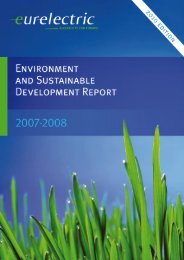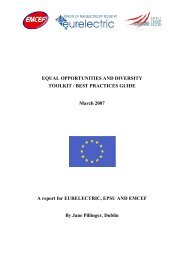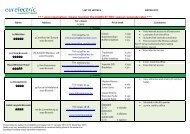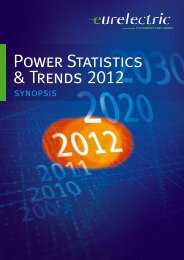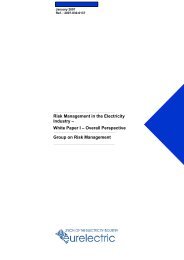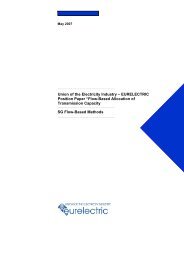EURELECTRIC comments on the draft BREF guidance document
EURELECTRIC comments on the draft BREF guidance document
EURELECTRIC comments on the draft BREF guidance document
You also want an ePaper? Increase the reach of your titles
YUMPU automatically turns print PDFs into web optimized ePapers that Google loves.
Dear Ms Wenning,<br />
Ms Marianne WENNING<br />
Head of Unit – DG ENV<br />
European Commissi<strong>on</strong><br />
Rue de la Loi 200<br />
BE – 1049 BRUSSELS<br />
Brussels, 22 March 2011<br />
<str<strong>on</strong>g>EURELECTRIC</str<strong>on</strong>g> would like to thank you for giving us <strong>the</strong> opportunity to participate to <strong>the</strong><br />
meetings held <strong>on</strong> 8 and 9 March. We welcome <strong>the</strong> <strong>draft</strong> <strong>guidance</strong> proposed by <strong>the</strong><br />
Commissi<strong>on</strong> and would like to make <strong>the</strong> following <str<strong>on</strong>g>comments</str<strong>on</strong>g>.<br />
Paragraph 1.1.1. (What a <strong>BREF</strong> is and its aim)<br />
<str<strong>on</strong>g>EURELECTRIC</str<strong>on</strong>g> supports efforts to streamline <strong>the</strong> c<strong>on</strong>tents of <strong>the</strong> <strong>BREF</strong>s but would like to<br />
stress that it is still necessary to provide competent authorities and all relevant stakeholders<br />
with informati<strong>on</strong> <strong>on</strong> <strong>the</strong> techniques applied in Europe. We remain supportive of a process<br />
that should provide sound technical and ec<strong>on</strong>omic informati<strong>on</strong>.<br />
Paragraph 1.1.3. (‘Horiz<strong>on</strong>tal’ and ‘vertical’ <strong>BREF</strong>s)<br />
<str<strong>on</strong>g>EURELECTRIC</str<strong>on</strong>g> would welcome clarificati<strong>on</strong> <strong>on</strong> <strong>the</strong> status and use of horiz<strong>on</strong>tal <strong>BREF</strong>s. Those<br />
are often crucial to <strong>the</strong> implementati<strong>on</strong> of <strong>the</strong> vertical <strong>BREF</strong>s.<br />
Paragraph 1.1.7. (Objective of a <strong>BREF</strong> review)<br />
<str<strong>on</strong>g>EURELECTRIC</str<strong>on</strong>g> supports efforts to streamline <strong>the</strong> c<strong>on</strong>tents of <strong>the</strong> <strong>BREF</strong>s and ensure an<br />
efficient process but it should be ensured that <strong>the</strong> BAT c<strong>on</strong>clusi<strong>on</strong>s and <strong>the</strong> whole <strong>BREF</strong> are<br />
fully c<strong>on</strong>sistent. In certain cases, <strong>the</strong> discussi<strong>on</strong> <strong>on</strong> <strong>the</strong> scope of <strong>the</strong> <strong>BREF</strong> may be an element<br />
<strong>the</strong> TWG will have to focus <strong>on</strong>.<br />
Uni<strong>on</strong> of <strong>the</strong> Electricity Industry - <str<strong>on</strong>g>EURELECTRIC</str<strong>on</strong>g> AISBL . Boulevard de l’Impératrice, 66 - bte 2 . B - 1000 Brussels . Belgium<br />
Tel: + 32 2 515 10 00 . Fax: + 32 2 515 10 10 . VAT: BE 0462 679 112 . www.eurelectric.org
Paragraph 1.2. (Generic schedule for <strong>the</strong> <strong>BREF</strong> review)<br />
<str<strong>on</strong>g>EURELECTRIC</str<strong>on</strong>g> supports <strong>the</strong> <strong>draft</strong>ing of shorter <strong>BREF</strong>s but would like to express its c<strong>on</strong>cerns<br />
about <strong>the</strong> proposed deleti<strong>on</strong> of <strong>the</strong> sec<strong>on</strong>d <strong>draft</strong> in <strong>the</strong> generic schedule for <strong>the</strong> adopti<strong>on</strong> or<br />
revisi<strong>on</strong> of <strong>BREF</strong>s. Intermediate steps are important, in particular in <strong>the</strong> new c<strong>on</strong>text<br />
established by <strong>the</strong> IED, and could prove extremely useful to solve specific problems or to<br />
avoid split views. It is difficult to imagine <strong>the</strong> <strong>BREF</strong> LCP could be revised according to <strong>the</strong> new<br />
proposed schedule given <strong>the</strong> scope of <strong>the</strong> <strong>document</strong> and <strong>the</strong> importance of a successful<br />
revisi<strong>on</strong> for all stakeholders.<br />
We questi<strong>on</strong> <strong>the</strong> necessity to merge <strong>the</strong> reactivati<strong>on</strong> of <strong>the</strong> TWG and <strong>the</strong> call for wishes as<br />
this would give insufficient time for appropriate preparati<strong>on</strong>.<br />
Paragraph 2.3.8. (Techniques to c<strong>on</strong>sider in <strong>the</strong> determinati<strong>on</strong> of BAT)<br />
We would like to ask for <strong>the</strong> inclusi<strong>on</strong> of <strong>the</strong> following relevant type of informati<strong>on</strong> in table<br />
2:<br />
'Envir<strong>on</strong>mental performance and operati<strong>on</strong>al data':<br />
• fuel should be added to <strong>the</strong> list of examples of inputs<br />
• fuel compositi<strong>on</strong> should be added to <strong>the</strong> list of operating c<strong>on</strong>diti<strong>on</strong>s<br />
'Applicability': <strong>the</strong> following should be added to <strong>the</strong> list of main restricti<strong>on</strong>s expected<br />
• operating pattern of <strong>the</strong> plant (e.g. base load with l<strong>on</strong>g c<strong>on</strong>tinuous annual operating<br />
time demand, peak load or mid-merit with many start-ups or very fluctuating load<br />
demand)<br />
• unreliability of performance<br />
• deficiency of wide references in heavy duty commercial operati<strong>on</strong><br />
Paragraph 2.3.9. (Best Available Techniques (BAT) c<strong>on</strong>clusi<strong>on</strong>s)<br />
We support <strong>the</strong> need for syn<strong>the</strong>tic BAT c<strong>on</strong>clusi<strong>on</strong>s but it is still essential that Split Views are<br />
clearly reported.<br />
Paragraph 3.2.3. (Informati<strong>on</strong> to assess <strong>the</strong> applicability of techniques)<br />
<str<strong>on</strong>g>EURELECTRIC</str<strong>on</strong>g> supports <strong>the</strong> explicit inclusi<strong>on</strong> of <strong>the</strong> load factor in <strong>the</strong> BAT c<strong>on</strong>clusi<strong>on</strong>s, to<br />
assess <strong>the</strong> applicability of techniques, as expressly requested by Finland during <strong>the</strong> IED<br />
Article 13 Forum Sub-Group <strong>on</strong> 8 March and taken up by <strong>the</strong> Commissi<strong>on</strong> in its c<strong>on</strong>clusi<strong>on</strong> <strong>on</strong><br />
<strong>the</strong> discussi<strong>on</strong>s <strong>on</strong> chapter 3 of <strong>the</strong> <strong>draft</strong> <strong>guidance</strong>. In <strong>the</strong> case of large combusti<strong>on</strong>s plants,<br />
for instance, a BAT suitable for base load operati<strong>on</strong> is not necessarily suitable for peak load<br />
operati<strong>on</strong>.<br />
2
Paragraph 3.3.1. (BAT c<strong>on</strong>clusi<strong>on</strong>s with BAT-associated emissi<strong>on</strong> levels)<br />
We support <strong>the</strong> need for BAT c<strong>on</strong>clusi<strong>on</strong>s to be associated with 'normal operating c<strong>on</strong>diti<strong>on</strong>s' but<br />
reference should be made to <strong>the</strong> possibility that many plant may not approach that efficiency or<br />
pollutant abatement capability because of low load factor, climatic c<strong>on</strong>diti<strong>on</strong>s or fuel diet.<br />
Paragraph 5.2. (Principles for data collecti<strong>on</strong>)<br />
We support <strong>the</strong> need for good data and <strong>the</strong> need for data from single installati<strong>on</strong>s. However, such<br />
data must be representative of <strong>the</strong> sector or else <strong>the</strong> data can be interpreted in such a way as to be<br />
reflective of c<strong>on</strong>diti<strong>on</strong>s or equipment prevalent in o<strong>the</strong>r locati<strong>on</strong>s. We support <strong>the</strong> need for<br />
informati<strong>on</strong> from <strong>the</strong> 'best' installati<strong>on</strong>s but efforts must also be made to understand <strong>the</strong> extent to<br />
which <strong>the</strong>se data are representative of <strong>the</strong> 'average' plant.<br />
Paragraph 5.3. (C<strong>on</strong>fidentiality issues)<br />
We would argue that TWG Members should not give details <strong>on</strong> <strong>the</strong> name of <strong>the</strong> installati<strong>on</strong>.<br />
Paragraph 5.4. (Informati<strong>on</strong> type)<br />
We would draw your attenti<strong>on</strong> to <strong>the</strong> paucity of <strong>guidance</strong> provided <strong>on</strong> costs. The <strong>BREF</strong>s must<br />
recognise that cost data can be highly site specific, especially for retrofit installati<strong>on</strong>s and will be very<br />
dependent <strong>on</strong> operating c<strong>on</strong>diti<strong>on</strong>s, fuel etc.<br />
Paragraph 5.5.5. (Energy)<br />
For "O<strong>the</strong>rs" both <strong>the</strong> steam and <strong>the</strong> heat used to produce electricity should be indicated to<br />
avoid duplicati<strong>on</strong> in collecting energy flows.<br />
Paragraph 5.5.7. (Reference informati<strong>on</strong>)<br />
Average values should also be given and calculated by c<strong>on</strong>sidering coherent figures<br />
regarding both “normal operating c<strong>on</strong>diti<strong>on</strong>s” and “o<strong>the</strong>r than normal operating<br />
c<strong>on</strong>diti<strong>on</strong>s”. Indeed <strong>the</strong> set of data should also be representative of worst cases, provided<br />
c<strong>on</strong>sistent c<strong>on</strong>diti<strong>on</strong>s.<br />
Whilst LCPs are generally designed for operati<strong>on</strong> at base load over a design lifespan, after a<br />
period of time, newer (and <strong>the</strong>refore more efficient or less costly) plant force older plant to<br />
operate at lower and lower annual output (or load factor) before being closed. From a BAT<br />
point of view, this is important since <strong>the</strong> reduced load factor, whilst c<strong>on</strong>tributing to a<br />
reducti<strong>on</strong> in total emissi<strong>on</strong>s, can impair a plant operator’s ability to retrofit abatement<br />
equipment. This mode of operati<strong>on</strong> needs to be addressed in <strong>the</strong> BAT <strong>guidance</strong>.<br />
3
Paragraph 5.6. (Specific issues)<br />
We disagree (p 45-under 'Note') that loads are not useful for deriving BAT AELs (see above<br />
<str<strong>on</strong>g>comments</str<strong>on</strong>g>)<br />
Best regards,<br />
John SCOWCROFT<br />
Head of Envir<strong>on</strong>ment & Sustainable Development Policy<br />
<str<strong>on</strong>g>EURELECTRIC</str<strong>on</strong>g><br />
4



